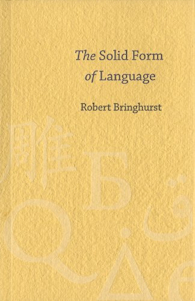Book Review
“Drop a word in the ocean of meaning”
Robert Bringhurst charts language
What are the differences between spoken and written language? What can these differences tell us about human communication and understanding? How has typography and design changed written language? Robert Bringhurst’s book “The Solid Form of Language, an Essay on Writing and Meaning” was written in 2002 for an anthology on language culture and type and republished by the Gaspereau Press in 2004. Bringhurst describes himself as a poet, linguist and typographer – in short someone with a wide interest in language. He has written “The Elements of Typographic Style” and has published books on native American poets, written about the interpretation of renaissance italian paintings[1]. To round out his impressive list of abilities, Bringhurst speaks, reads and writes in a range of languages. His poetic nature is clear right from the start: “Drop a word in the ocean of meaning and concentric ripples from. […] To catch the meaning of the words is not to catch the ripples that they cause; it is to catch the interaction of those ripples. This is what it means to listen; this is what it means to read. It is incredibly complex, yet humans do it every day, and often laugh and weep at the same time.” (p. 9) This poetic beginning and the elegant pocket format set the scene for a brief intellectual journey into written language.
From this poetic indeed almost visual beginning Bringhurst takes his readers on a breathless trip through a history of written languages and their development, the uniqueness and fundamental differences between written and spoken language. Bringhurst writes: “Starting from scratch, with no imported models, people have made the shift from oral to literate culture at least three times … In Mesopotamia, about 5,000 years ago, in northern China about 4,500 years ago, and in Guatamala and southern Mexico about 2,000 years ago, humans created a script and a scribal culture, apparently without imported models of any kind.” (p. 14) These early systems were all originally picture-based or drawn. After a precise definition of writing (to differentiate it from drawing) the four points listed here are discussed in greater detail. “(1) Writing is abstract. […] (2) A writing system is codified. It consists of a repeating set of symbols […] (3) These symbols are defined in terms of something else. […] (4) The system is stylistically as well as symbolically self-contained.” (p. 16f) He covers a small selection of scripts including: basic chinese glyphs, latin, arabic, korean and native american writing systems as well as discussing their stylistic heritages. Bringhurst differentiates the spoken languages as evolved and evolving, and written language as invented and trained (p. 12–13). This link in written language to “religious or political authority” (p. 24) makes scripts emblems of cultures and belief systems, and like belief systems connected with religions and empires often rigorously spread.
Bringhurst also looks at the evolution of our western european ways of writing, and how typographic style extends the original boundaries of our language. His central example (p. 45–47) is “Leonard Fuchs’s botanical work De Historia stirpium, first published by the Basel printer Michael Isengrin in 1542.” (p. 44) The mixing of scripts (whether more calligraphic or constructed) in a single sentence is now common, indeed this review is full of changes from roman to italic and back. So much so that we often fail to read its significance: a change in voice or tonality. In this way aspects of spoken language has slowly transferred to writing. Bringhurst also emphasizes that the use of other typographic styles indicate shifts in content. These ideas were revolutionary in the Renaissance and changed how we write and read today.

